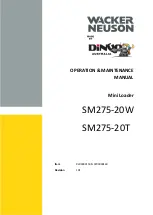
-
Wait until the various parts of the machine reach the operating temperature after starting the
engine.
-
Make sure that every controller and function of the machine operates normally.
-
Remove any dirt, snow and ice from the machine after completing the operation, and park the
machine on a wooden pallet.
(2) Operating in extremely hot environments
•
Continuous operation of the machine for a long period of time may cause the machine to overheat.
Pay special attention to prevent the overheating of respective parts such as the engine and the hy-
draulic system, and stop the machine and take a break if necessary.
Check the following conditions frequently :
-
Check the level of the coolant in the radiator.
-
Check the radiator grill for clogging by pollutant, and remove them, if any.
-
Check the level of the battery electrolyte.
-
If the battery will not be used for a long period of time, store it in a cool place.
-
Check the hydraulic system for oil leakage.
-
Check the lubrication oil on the respective parts, and top up the oil if necessary.
-
If the paint coating of any parts has been effaced or damaged, coat the parts with paints or
treat them with an anti-rust additive.
-
Do not park the machine under direct light for an a long period of time.
-
When parking or storing the machine outdoors, use the proper cover to protect the machine
from sunlight and dust.
(3) Operating in dusty or sandy environments
•
Check the radiator grill for clogging by pollutant, and remove them, if any.
•
Check the fuel system, and protect it from dust or sand when refueling.
•
Inspect the air cleaner regularly, and replace it if necessary.
•
If the gauge lamp on the dashboard lights up and the buzzer sounds at the same time, clean or
replace the air cleaner independently of the usual inspection cycle.
•
Frequently check consumables such as hydraulic oil and lubrication oil, and change them if neces-
sary. Pay attention to prevent the introduction of dust or sand when changing the consumables.
•
Check the air-conditioner and the heater filters regularly, and clean or replace them if necessary.
•
When parking or storing the machine outdoors, use the proper cover to protect the machine from
dust and sand.
(4) Operating in rainy or humid environments
•
Do not operate the machine in areas where there is heavy rainfall or thick fog.
•
If operating the machine in such areas is unavoidable, perform operation after ensuring sufficient
field of vision.
-
Use lighting devices such as the head lamp and working light.
-
Warn any workers within the radius of operation of the machine.
•
Pay attention when operating the machine on smooth ground as there is a risk of it overturning.
•
If the paint coating on any parts has been effaced or damaged, coat the parts with paints or treat
them with an anti-rust additive.
(5) Operating the machine in coastal areas
•
Special care should be taken when operating the machine in coastal areas as exposed parts may
be corroded easily.
1-18
Summary of Contents for HL930A
Page 1: ...WHEEL LOADER OPERATION MAINTENANCE MANUAL HL930A HL930A XT Serial No ...
Page 2: ......
Page 4: ......
Page 25: ...1 CALIFORNIA PROPOSITION 65 SAFETY HINTS 1 1 ...
Page 133: ...13 REAR CAMERA option 1 The rear camera is available as a option Refer to page 3 39 3 75 ...
Page 147: ...15 CAMERA MONITOR OPTION 3 89 ...
Page 149: ... 2 Interlocked with other devices 3 91 ...
Page 150: ... 3 Operation scenario Single camera mode 3 92 ...
Page 151: ... 4 Operation scenario AAVM mode 3 93 ...
Page 152: ... 5 AAVM view mode type 3 94 ...
Page 153: ... 6 Function menu tree Single cam mode 3 95 ...
Page 154: ... 7 Function menu tree AAVM mode 3 96 ...
Page 155: ... 8 Parking guide line adjust 3 97 ...
Page 156: ... 9 How to set function menu 3 98 ...
Page 157: ... 10 Composition of menu screen 3 99 ...
Page 158: ... 11 Value adjustment 3 100 ...
Page 159: ... 12 When radar mounted monitor display 3 101 ...
Page 160: ......
Page 260: ...9 2 ...
Page 261: ......
Page 262: ...EN English E1 September 2020 PART NO 91WA 32040 ...









































